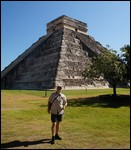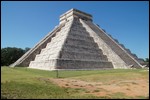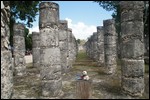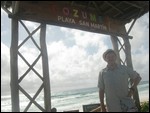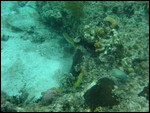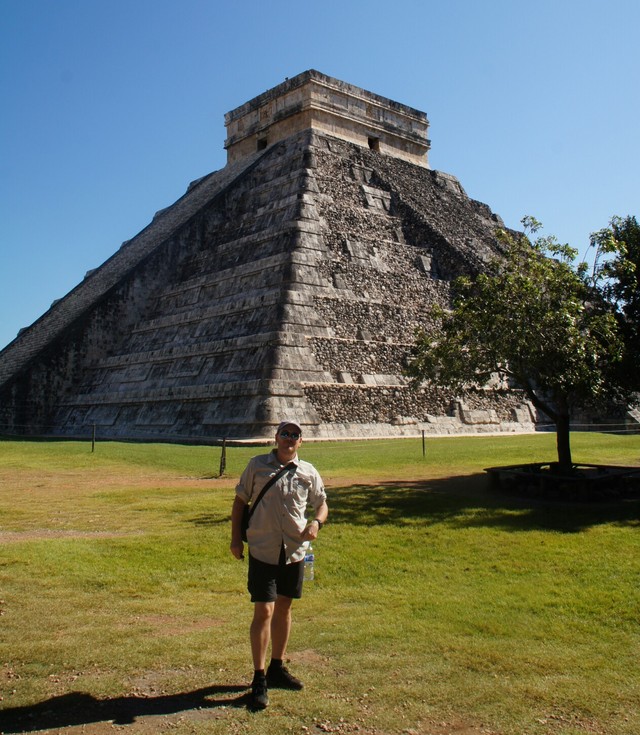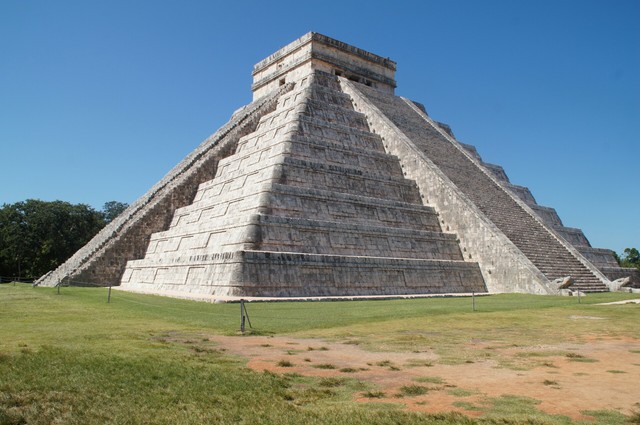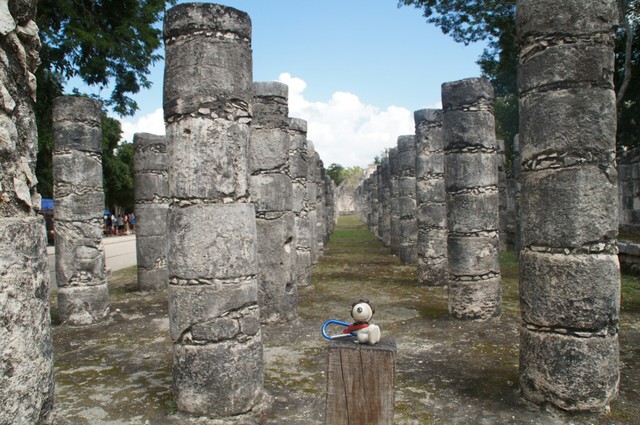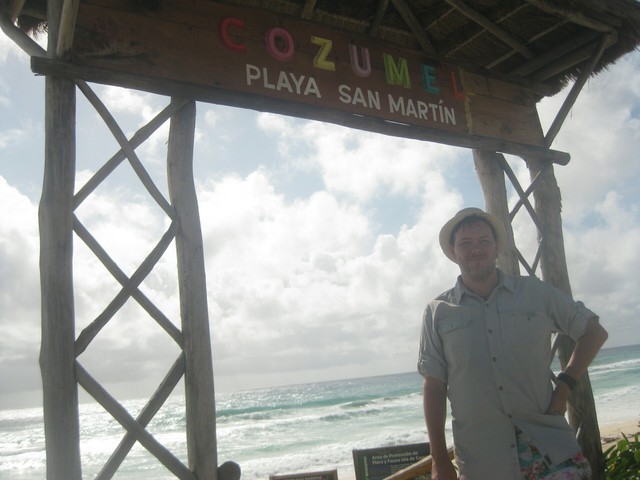Early morning, 7 AM, I took another ride in an old-timey car, but this time, not just for shits and giggles and sightseeing. My plane left for Cancun in the morning, and I arrived at the airport in style.
Sometimes the difference between two neighbouring nations can be obvious. I mean, look at how weird they are in Norway once you cross over from Sweden: The lines of their roads are yellow rather than white! What is up with that? And even though Cuba and the Yucatan part of Mexico are fairly similar in climate, and on good days you could probably see the shores of the other land, and neither of them are exactly poor, the difference is striking. Especially in Cancun. A Las Vegas strip by the Caribbean, high rise all-inclusive hotels, fancy private beaches, neon signs, golf courses, restaurants, night clubs and tacky souvenir shops line the narrow peninsula. It's a market's market, tourism is the product and tourists are the clients.
Although, there are similarities. In Cuba, especially in the cities, you could hardly walk a metre without someone calling you amigo and urge you to purchase something. Only, in Cuba, it was mostly taxis, cigars, genuine local handicrafts and rum they peddled; in Cancun, they try to sell you Jet Ski tours, women, genuine local handicrafts and nightclub limo rides. When, oh when, will the merchants of the world realise that if I need a product or a service I, and everybody else, am perfectly capable of seeking it out myself?
At ridiculous o'clock the bell rang. Some four hours drive from Cancun lies one of the current Seven Wonders of the world: Chichen Itza. Drawing tourists from near and far, this former Mayan capital is a destination best reached before the crowds. Said and true, the bus hit the highway at 7:00 after a round of picking up passengers from 5, starting with me. As such, we were indeed the second bus to arrive, and could therefore beat the crowds and, to a lesser extent, the heat.
The main attraction, the Kukulcan Pyramid, was a little bit smaller than what I had expected, but not less impressive. It is well known, for those who know it well, that the pyramid is built in such a way that, given the right time of day and year, shadows will work in mysterious and, for the uneducated, divine ways. Our local guide was very entertaining and knowledgeable, and he told the tale of the Mayans. Knowledge is power, and hiding that knowledge from the people while claiming divine communication is essential for any religion. The brightest and best architects, engineers, astronomers and acoustic scientists knew how to build structures to appear as though in direct contact with the gods, and the brightest and best leaders knew how to utilise this in order to dupe the masses. So, pretty much the same as today, in many places.
I knew about the shadows (though I didn't know the specifics, that being that during the equinox they would appear as a serpent slithering down the pyramid), but I did not know about the acoustic phenomena. Clap your hands, and at a certain angle the echo sounds like a bird calling. Clap your hands, and at a certain other angle it sounds like a rattle snake.
At most there were about 100,000 people in Chichen Itza. 5000 were the elite; the priests, the nobles, the astronomers, the ball players. They lived inside the sacred city, the rest could well and true live outside.
The well put-on shows every six months, with astonishing displays of communicating with the gods (through means of shadowplay and acoustic trickery) kept the population in check. When the rulers needed firewood for the mortar, the people happily cut down the surrounding trees. When they needed more, they cut down more trees, and eventually an area consisting of present Yucatan, Belize, Nicaragua, Honduras and Guatemala were deforested. Without jungle, no persistent water, and no life. The hunger for power by the Mayan rulers eventually led to the downfall of the Mayan civilisation. Well, maybe the Spanish helped.
In the sacred city there is also a ballpark. A ball game, not unlike a mixture of basketball, baseball and quidditch, was the national sport. Every two years or so, the cup final was played in Chichen Itza. Each team consisted of 7 players, but the lucky number was not 7, or 14, but 13. Therefore, after the game, one player would have to be sacrificed in order to please the gods. So who? The goalie who let that fatal ball in? The striker that missed an open goal towards the end of the game? The Gary Sundgren of the era? No, being sacrificed was a great honour, and that honour went to the captain of the winning team. Swinging the actual sword was also a great honour, bestowed upon the captain of the losing team. And you thought our contemporary football games are matters of life and death!
The camera went warm, and so did the air. A bit past noon we had managed to take in the whole city, and it was time to head on back. By this time, the parking lot was jam packed with buses, and the early bird special had really payed off!
Cancun is an underwater paradise. Coral reefs, turtles, sharks, dolphins and schools of colourful fish awaits in the turquoise blue waters. However, my blood thinners were still in my system, and so Scuba diving was out of the question. I can do that wherever, after the effects have worn off. One thing they have in Cancun and no place else is the underwater museum. Lots of statues and sculptures placed on the ocean floor make for a spectacular sight, as well as artificial reefs. Shallow enough to be seen via snorkeling, I booked a tour and set off early in the morning. Unfortunately, the sea was angry that day, my friends, and they had to cancel the trip. And since I had to leave for Cozumel, I had no choice but to take the refund rather than wait another day to see if the seas would calm down. Maybe that was just as well; Now I have a reason to come back, and that time do it all properly, with flasks and BCD:s.
The day was instead spent going for a walk (past the crocodile warning signs), contemplating whether or not to do the aquarium (opting not to), relaxing by the (IMNSHO calm sea) and not having to stress to reach my next port of call before sundown. I took the local bus from the hotel peninsula to the bus station downtown and jumped on the cheap coach to Playa del Carmen. From there the ferry was ready to take me across the the increasingly wavy water to the island of Cozumel.
The heavens were angry that day, my friends! Heavy rain fell from dawn till dusk, and I ventured out in between the showers for some shopping for a cheap-arse mask+snorkel and a Splash guard, but otherwise it was just me and my hotel pool and my reading.
The weather looked more promising the next day, though, and I went for a guided tour of the island. The waves, having been built up from travelling the Atlantic, broke majestically on the sparsely populated and seldom touristed eastern side. A catholic church had been built right next to an old mayan temple. The sky started to look a bit more threatening, and before late I put on a mask and flippers and snorkelled around the local reef.
The half-day ended with a visit to an organic and artisenal tequila factory, where focus lay less on the making-of process (though that was an essential part as well) and more on tasting the different flavours. Four straight kinds, each more barrel aged than the last, and some five or so seasoned with fruits, coffee and more. Most of them were fine, with the añeja being the tastiest and the almond being quite horrible.
Soon enough I caught the ferry to the mainland, sought out my hotel in Playa del Carmen and got ready for the pre dep meeting.
